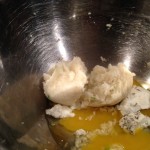 I recall the days of making cauliflower pizza crust for my son when he was on the ketogenic diet. My family found it surprisingly delicious. At that time the recipe we acquired was a bit more labor intensive. Being the hunter that I am, I found a new-to-me recipe that cuts down the preparation to 10 minutes but do allow 55 minutes for baking time (can’t seem to reduce the baking time yet). Did I mention the total recipe only requires 3 main ingredients?
I recall the days of making cauliflower pizza crust for my son when he was on the ketogenic diet. My family found it surprisingly delicious. At that time the recipe we acquired was a bit more labor intensive. Being the hunter that I am, I found a new-to-me recipe that cuts down the preparation to 10 minutes but do allow 55 minutes for baking time (can’t seem to reduce the baking time yet). Did I mention the total recipe only requires 3 main ingredients?
2 pounds cauliflower florets, riced
1 egg, beaten
1/3 cup soft goat cheese (chevre)
1 teaspoon dried oregano
pinch of salt
Directions:
Preheat your oven to 400F, then get to work on your crust.
Step 1: Begin by making your cauliflower “rice.”
Simply pulse batches of raw cauliflower florets in a food processor, until a rice-like texture is achieved.
Step 2: Cook & Strain the rice.
Fill a large pot with about an inch of water, and bring it to a boil. Add the “rice” and cover; let it cook for about 4-5 minutes. Drain into a fine-mesh strainer.
Now here comes the secret:
Once you’ve strained the rice, transfer it to a clean, thin dishtowel.
Wrap up the steamed rice in the dishtowel, twist it up, then SQUEEEEEEEZE all the excess moisture out! (Be careful not to burn your hands!)
It’s amazing how much liquid will be released, which will leave you with a nice and dry pizza crust.
Step 3: Make & Shape the dough.
In a large bowl, mix up your strained rice, beaten egg, goat cheese, and spices.
Don’t be afraid to use your hands! You want it very well mixed.
It won’t be like any pizza dough you’ve ever worked with, but don’t worry– it’ll hold together!
Press the dough out onto a baking sheet lined with parchment paper. (It’s important that it’s lined with parchment paper, which is not to be confused with WAX paper– they’re very different!) ON a side note I used a silicone mat.
Keep the dough about 1/3″ thick, and make the edges a little higher for a “crust” effect, if you like.
Step 4: Bake!
Bake for 35-40 minutes at 400F.
It’s that easy and absolutely delicious.
Be well,
Lynn
P.S. I need to spread credit where credit is due: thanks to www.detoxinista.com for this updated recipe.

 January 11th, 2016
January 11th, 2016  Lynn
Lynn 
 Posted in
Posted in  Tags:
Tags: 
